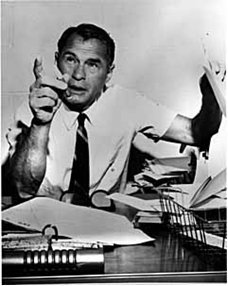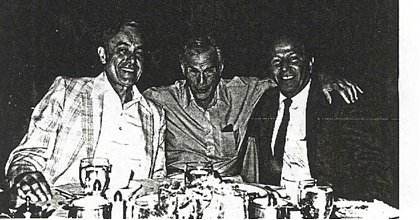
Hank Greenspun was born in Brooklyn on the 27th August 1909. He studied law before joining the United States Army and during World War II he was sent to Europe. While in Northern Ireland he met his future wife, Barbara Ritchie. As a member of the ordnance corps, he served under General George Patton during the advance through France and Germany. Greenspun was decorated with the Croix de Guerre for his courage in the Battle of Falaise Gap. By 1945, he had reached the rank of major.
In late 1947, Greenspun was recruited by the Haganah. The nation of Israel was to be re-established in 1948 as a homeland for Jews. War was certain, and Israel had few weapons. In his autobiography, he describes clandestine expeditions to buy artillery and rifles in Latin America, and airplane engines and machine guns from a surplus yard in Hawaii. He was caught and in 1950 pleaded guilty to violating the Neutrality Act. He was fined $10,000 but the judge, attributing the crime to noble motives, refused to sentence him to prison.
“A Giant who fought for Israel,” by Al Ellis
On the cover of Greenspun’s autobiography “Where I Stand,” Alex Pelle writes: “… a man of principle who was willing to face death, jail and the loss of his life as well as the destruction of his career to do what he considered was his duty.”
“…Particularly daring were Greenspun’s perilous activities as a gunrunner for Israel’s Haganah: He plundered a naval depot in Hawaii; he seized a private yacht in California; and he posed in Mexico as a confidential agent of Chiang Kai-Shek.”
I first met Hank on a dark night in May 1948 after volunteering my expertise as a seaman and I was directed to report to Hank on the 60ft schooner “Idalia” docked in a remote section of the Los Angeles harbor.
The boat was riding extremely low in the water, almost to the point of being unseaworthy. The reason was obvious. It was loaded with almost 1,000 30- and 50- caliber machine guns weighing over 15 tons. Hank had somehow obtained these machine guns in Hawaii, shipped them to Los Angeles and loaded them onto the schooner for shipment to Israel via Mexico. All this was done with the authorities hot on his trail every step of the way. I was the navigator and able-bodied seaman. Nat Ratner, who had previously served on the “Altalena,” was the engineer, and Lewis, the owner, was skipper of the boat.
As I shook hands with Hank, ominous events began: Hank was notified that the FBI was on the way to seize the boat, confiscate its cargo and arrest everyone. Hank ordered the “Idalia” immediately to sea even though there was insufficient food, water, or fuel for the trip to Acapulco. Lewis, although well-paid, ordered us to immediately unload the cargo and leave his boat. Hank ended the discussion by pointing a loaded gun at Lewis’ head and ordering him to “co-operate.” We reached the three-mile-limit and headed south with ships and planes in pursuit, some friendly, some not.
Two weeks later, after a 1,800-mile voyage filled with many trials and tribulations, we limped into the port of Acapulco, where Hank had arranged for us to be met by the presidential yacht. The cargo was then unloaded and shipped to Mexico City.
The Giant Hank, posing as a Chinese general, then went on a purchasing mission, checking and raiding every military storehouse in Mexico. He purchased millions of rounds of ammunition, thousands of rifles, artillery pieces, anti-tank guns, bombs, howitzers, and more, even cannons from the days of Pancho Villa. Everything was loaded into two long freight trains and transported to Mexico’s east coast port of Tampico. Each car was guarded by one Mexican soldier. Nat was in charge of one train, and Hank the other.
Upon arrival in Tampico, the munitions were quickly loaded into the bottom holds of the “Pinzon,” an old rusty Panama-registered cargo ship, barely seaworthy and on its last legs. It had sailed from San Francisco through the Panama Canal and had just made it to Tampico. The munitions were camouflaged with hundreds of tons of sugar.
The loading completed and preparations underway to sail, the Mexican authorities suddenly seized and interned the ship. After several days of feverish activities, the “Chinese” Giant had miraculously obtained permission for the ship to sail. Once at sea, the Pinzon was repainted and renamed the “Kefalos.”
After over a month at sea, traveling under radio silence, no lights, and evading the British, with almost no supplies, water, or fuel left, the “Kefalos” arrived in the Tel Aviv harbor on 8th September 1948 and silently dropped anchor.
United Nations inspectors came on board, inspected and certified the “Kefalos” as an innocent cargo ship carrying sugar. Sugar was unloaded during the day, while the real cargo was unloaded at night.
Alex Pelle writes: “Artillery, rifles, machine guns and ammunition from the hold of the “Kefalos” were distributed immediately. By the opening of the second round, the army offensive using the “Kefalos” guns, blasted out victory in the Battle of the Negev.”
Two years later, seven of us, including Hank, were indicted and brought to trial in Los Angeles for this operation. Just prior to the start of the trail, Hank again proved that he also had the heart of a giant. He pleaded guilty only on the condition that all charges against the rest of us were dismissed.

Left to right: Nat Ratner, Hank Greenspun and Al Ellis
Note: In 1993 The Hank Greenspun Plaza was dedicated to Hank’s memory in Jerusalem.
Source: Internet, and American Veterans of Israel Newsletter: October 1990

